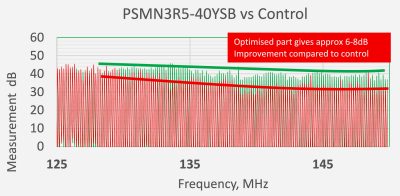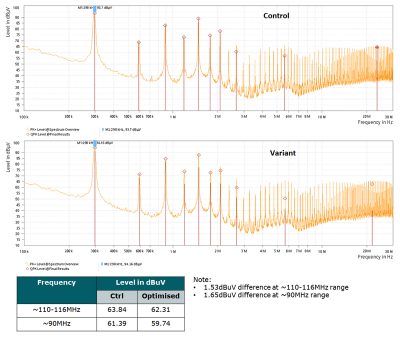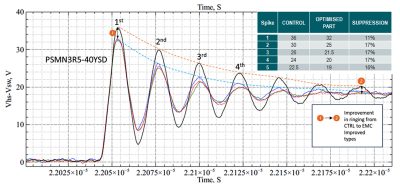FTM / Motor Control / Nexperia — NextpowerS3 40 V MOSFETs
Industrial motor drives that switch large currents through MOSFETs are prone to high levels of electromagnetic emissions. The MOSFETs used in these applications will affect EMI differently, depending on several factors such as the speed of turn-on/turn-off, and the ability of the output network to limit spiking and to damp harmonic content.
Now a range of products from Nexperia balance the dynamic characteristics of the MOSFET and increase damping to ensure that EMC performance is improved. This makes it easier to design the MOSFETs into new or existing designs and to tolerate imperfect board layouts. Nexperia EMC-optimized MOSFETs help OEMs to meet EMC requirements, and give designers confidence that the product will pass, reducing time to market and lowering development costs.
Alternative methods of meeting EMC test specifications are available to designers:
But these techniques increase bill-of-materials cost and impair system performance. Nexperia’s EMC-optimized MOSFETs improve EMC performance without over-engineering or adding cost.
Additionally, some designers will fit an external snubber across each MOSFET, adding to power losses, to improve EMC performance. This snubber usually needs to be matched to a specific MOSFET, and is not normally effective for a different MOSFET. The Nexperia optimized MOSFETs provide a similar outcome without the need to design a snubber circuit, with the benefit of higher overall efficiency and lower system costs.
Applications that can benefit from the use of EMC-optimized Nexperia MOSFETs include:

Fig. 1: Comparison of radiated emission on motor-drive board using close field probe
Figure 1 shows the results from testing performed on Nexperia’s Trinity motor-control board, comparing the EMC performance of an optimized Nexperia device, the PSMN3R5-40YSB, with that of a competing product. The average noise floor is raised by between 6 dB and 8 dB in the frequency range 125 MHz to 150 MHz. Individual peaks improve by as much as 12 dB.

Fig. 2: Comparison of conducted emissions on power-supply evaluation board
Figure 2 shows a plot of conducted emissions, again comparing a Nexperia EMC-optimized MOSFET with a standard MOSFET. The MOSFETs were fitted to a readily available step-down dc-dc converter evaluation board that produces a 12 V/10 A output. The snubber was removed from the board for the purpose of testing. The board layout itself minimizes EMI. This gives heightened significance to the 1.65 dB reduction in emissions attributable to the EMC-optimized MOSFET.

Fig. 3: Measurements performed on HCDP test gear show that Nexperia EMC-optimized MOSFETs provide better damping and spike suppression than a competing standard MOSFET
Figure 3 shows how the optimized MOSFET tested on high-current double-pulse (HCDP) test gear provides damping and spike suppression up to 17% better than the control. This will produce improved EMC performance in application designs.
Conclusion
EMC performance is dependent on several factors, and it is impossible to solve all EMC problems by replacing the MOSFET. The EMC-optimized MOSFET portfolio from Nexperia, however, is a valuable option for designers dealing with circuits in which EMC compliance is proving difficult.
The Nexperia EMC-optimized MOSFETs are supplied in a 100% clip-bonded LFPAK56 package. This package is robust, offers high board-level reliability and provides excellent thermal performance. The LFPAK56 is footprint-compatible with all widely used DFN56 packages.
Figure 4 shows the MOSFETs available in the EMC-optimized portfolio at the start of 2024.
Part Number | Maximum Drain-source Voltage | Maximum On-resistance at a Gate-source Voltage of 10 V | Maximum On-resistance at a Gate-source Voltage of 4.5 V | Maximum Drain Current |
PSMN1R7-40YLB | 40 V | 1.8 mΩ | 2.3 mΩ | 200 A |
PSMN1R9-40YSB | 40 V | 1.9 mΩ |
| 200 A |
PSMN2R0-40YLB | 40 V | 2.1 mΩ | 2.7 mΩ | 180 A |
PSMN2R2-40YSB | 40 V | 2.2 mΩ |
| 180 A |
PSMN2R5-40YLB | 40 V | 2.6 mΩ | 3.3 mΩ | 160 A |
PSMN2R8-40YSB | 40 V | 2.8 mΩ |
| 160 A |
PSMN3R2-40YLB | 40 V | 3.3 mΩ | 4.2 mΩ | 120 A |
PSMN3R5-40YSB | 40 V | 3.5 mΩ |
| 120 A |
Fig. 4: The Nexperia portfolio of EMC-optimized MOSFETs
Be at the forefront of New Technology Innovations
Be at the forefront of New Technology Innovations
© 2024 Future Electronics. All rights reserved. Privacy | Terms & Conditions of Sale | Terms of Use | Accessibility